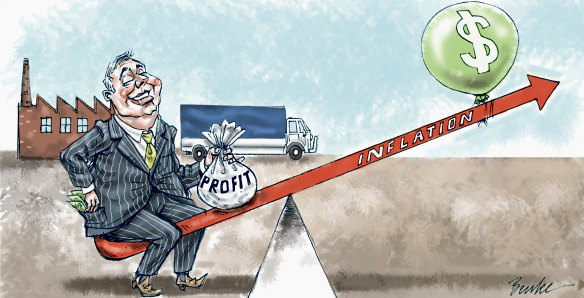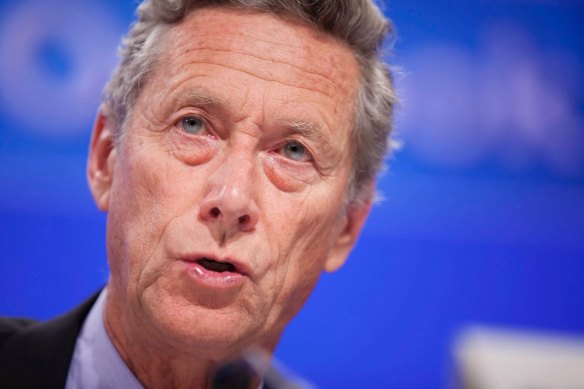
Say what you like about inflation, just don’t mention this dirty word
There’s a big risk we’ll fail to learn a vital lesson from our worst inflation outbreak in decades. If inflation is such a scourge that we must pay a terrible price to get it back under control, why do we do so little to stop big companies from acquiring the power to raise their prices by more than needed to cover their rising costs?
Economists are far more comfortable thinking about inflation at the top, macro level than the bottom, micro level. At the top, inflation is caused by aggregate (total) demand for goods and services growing faster that aggregate supply – the economy’s ability to produce those goods and services.
Credit:
We know from Reserve Bank figuring that more than half the price rise we’ve seen has come from temporary disruptions to the supply of production inputs, caused by the pandemic and the Ukraine war.
But, the Reserve insists, prices have also risen because demand’s been stronger than it should have been. Why? Because in our efforts to hold the economy together during the pandemic, we applied far more economic stimulus than was needed.
Economists – even those who stuffed up the stimulus – are comfortable with this explanation because it puts the blame on government. The model of the economy they carry in their heads tells them the market usually works fine, whereas it’s government intervention in the market that usually causes the problems.
So, you can see why economists were so discombobulated when one of the world’s top macroeconomists, Olivier Blanchard, tweeted about “a point which is often lost in discussions of inflation”. “Inflation,” he wrote, “is fundamentally the outcome of the distributional conflict between firms, workers and taxpayers.”
‘Economists are infinitely more reticent in urging businesses to go easy with their price rises.’
He’s saying economists need to look at the more fundamental, bottom-up factors driving inflation. Is worsening inflation caused by workers and their unions successfully demanding real wage rises higher than the increasing productivity of their labour justifies?
Or is the strength of competition insufficient to do what the mental model promises: prevent firms from raising their prices beyond what’s needed to cover their higher costs (including a “normal” return – profit – on the capital invested by their owners)?
The strange fact is that economists and econocrats have a long history of lecturing workers and unions on the need for wage restraint. Reserve Bank governor Dr Philip Lowe has been saying workers must be “flexible” and accept wage rises far less than the rise in consumer prices. That is, take a big pay cut in real terms.
But economists are infinitely more reticent in urging businesses to go easy with their price rises. I suspect this is partly because of the biases hidden in their mental model, but mainly because they know their employer, or the big-business lobby, or its media cheer squad, or all the business people on the Reserve’s board, would tear into them for daring to say such a thing.
Olivier Blanchard: “Inflation is fundamentally the outcome of the distributional conflict between firms, workers and taxpayers.”Credit:Stephen Jaffe
Similarly, economists have insisted the Australian Bureau of Statistics publish any number of different measures of wage growth, but few measures of profit growth.
Last month, Dr Jim Stanford, of the Australia Institute, sought to even things up a bit by publishing figures that broke the inflation rate up into the bit caused by rising wages and the bit caused by rising profits.
He found that “excess corporate profits account for 69 per cent of additional inflation beyond the Reserve Bank’s target”, whereas rising labour costs per unit of production (that is, after adjusting for the productivity of labour) account for just 18 per cent.
What? Huh? Never seen an exercise like that before. How’d he cook that up? The business lobby went on the attack and the business press consulted a few economists who lazily dismissed it as nonsense.
But though it’s unfamiliar, it’s not as weird as you may think. Stanford was copying the method used by some crowd called the European Central Bank. What would they know?
Well, OK. But how can you take the rise in the prices of products over a period and “decompose” it (break it down) into the bit caused by rising wage costs and the bit caused by rising profits?
By taking advantage of the fact that, every time we measure the growth in gross domestic product in the “national accounts”, we measure it three different ways.
First, the growth in the nation’s expenditure on goods and services. Second, the growth in the nation’s income from wages, profits and other odds and sods. Third, the growth in the production of goods or services by each of our 19 different private and public sector industries.
In principle, each way you measure it gives you the same figure for GDP. Then you use a “deflator” to divide the growth in nominal GDP between the bit caused by higher prices and the bit caused by higher quantities – the “real” bit.
So, it’s quite legitimate to take this measure of inflation and break it up between higher wages and higher profits (leaving the bit caused by changes in taxes and subsidies).
Actually, the stats bureau’s been doing this exercise for wages (“nominal unit labour costs”) for decades, but not doing it for profits (because no one’s been keen to know the results).
Note that the “GDP deflator” is a quite different measure of inflation to the one we usually focus on: the index of consumer prices.
Note, too, that the Ukraine war has caused a huge jump in the profits of our energy producers. This windfall hasn’t been caused by businesses sneaking up their profit margins (“mark-ups”, as economists say). But the growth in mining industry profits accounts for only about half the rise in total profits over the three years to December 2022.
I’m not comfortable relying on a think tank for these figures. But if the economists who champion big business don’t like it, they should take this exercise seriously and join the debate. The government should ask the stats bureau to finish doing the numbers itself.
Ross Gittins is the economics editor.
Ross Gittins unpacks the economy in an exclusive subscriber-only newsletter every Tuesday evening. Sign up to receive it here.
Most Viewed in Business
From our partners
Source: Read Full Article

